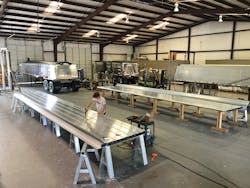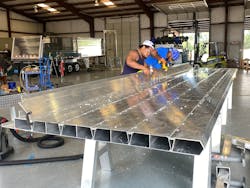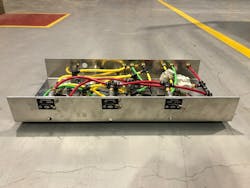Hicks Manufacturing applies ‘weld-free’ process to end-dumps
FIVE years ago, Hicks Manufacturing founders Greg Hicks and DeWayne Williams found themselves surrounded by what might be described as a full-scale Erector Set, and if they followed the instructions those pieces would fit together to build a first-of-its-kind end-dump trailer body. By January 2016, the “two old engineers” had assembled the original Hicks T6.
“There’s a very, very small amount of skilled labor that’s needed to build this trailer,” Hicks says. “One of the beauties of it is there’s no welding. A lot of these parts snap together. Everything is really built into the engineering.”
That trailer—along with 150 subsequent builds—is still on the road, proving the now-patented concept: a weldless aluminum trailer body, built from a kit of precisely designed extrusions, is both lighter and stronger than conventionally built trailers.
“We haven’t seen a crack anywhere. Not one,” Hicks says. “In those areas where trailers are welded, the strength of that aluminum drops almost 80%. Whereas when you drill a hole, you don’t destroy any of your temper or any of your yield strength.”
And that’s the essential reason for building the Hicks T6 with mechanical fasteners: to preserve the full temper strength of the aluminum extrusions and avoid structural cracking. Hicks boasts that his material is at least two-and-a-half times stronger in the joints.
But coming up with an innovative design and production process was, in some ways, the easy part.
“The biggest hurdle is you’re coming to market with, number one, a company that’s new. [Customers] have never heard of a Hicks trailer before,” he says. “Then, to top it all off, you’re coming out with something that’s built entirely different than everybody else. There was a lot of intrigue; I never heard anybody saying, ‘well, that’s not going to work.’ They liked the idea, but at the same time, there was a lot of wait-and-see. It’s just hard to get your name out there.”
Industry expertise
Getting one’s name out is harder for some than for others. Hicks and Williams each have decades of experience in the trailer industry.
Hicks had been president of Clement Industries, a Minden, LA-based dump trailer manufacturer formed in 1976 by his father, Glen Hicks. Williams joined Clement as chief engineer in 2006 after already gaining 25 years of engineering experience in the transportation industry, including stints at Wabash National and Vanguard.
The Hicks family sold Clement to Ligon Industries when Glen retired in 2007, with Greg staying on a couple of more years for the transition before easing into retirement as well.
But by 2010, father and son were once again talking about building trailers.
“I had the thought: Is there some way we could build an aluminum trailer without welding at all?” Hicks recalls. “We had done a little bit of that before with some sub-assemblies on aluminum trailers—and it was quite successful.”
They brought on Jack McKenney as a consultant to draw up the plans, and he “fundamentally put together” the weld-free double-walled design used today. And, Hicks explains, they fully intended to build the trailer.
But when his mother, Phyllis, became ill, “my dad was 100% focused on her and the project got put on hold,” Hicks notes. “Then in 2014 I just had a renewed interest. I got together with DeWayne and showed him what we had. I told him if he’s interested, we’ll make a go of this thing; if not, then we’ll just forget it. He liked what he saw, left Clement, and we took it from there.”
Hicks credits Williams with “quite a few” changes that made for a “more practical” design and a better product.
“There are some components that are aluminum sheet that are laser cut and formed, but most of the trailer body is made from extrusions,” he says. “We have over 20 dies that we had to get designed, and then we had to get the product in. So it wasn’t until around September or October 2015 when we had enough materials to start building the trailer.”
Nuts and bolts
Hicks Manufacturing occupies a 14,000-square-foot shop in Minden—a town just east of Shreveport on I-20—on a large lot with room for expansion.
“Our manufacturing philosophy is to outsource wherever practical,” Hicks says. “Our body consists entirely of extrusions, most of which are delivered to us pre-cut and machined. The few accessories made from aluminum or steel plate are laser cut and formed by vendors.”
The design received a patent in April, although Hicks admits the approval process was a challenge.
“I don’t want to say it was more trouble than it’s worth, but it was certainly more trouble than I expected,” he says. “From the time we first sat down with an attorney to when we finally got the patents was the better part of three years.”
Hicks, Williams and McKenney share the inventor credit on the patent that includes 17 design features—none of which were challenged in the review, Hicks points out. Notably:
- The sides wall, nose and tailgate are 3.375” wide, adding torsional strength. They connect with hooks and slots on the outside, and serrated tabs on the inside. Replacement of damaged components is simplified.
- The floor consists of alternating plates and crossmembers that interlock. With no welding, the floor remains perfectly flat. Again, replacement of damaged components is simplified.
- The subframe consists of trapezoidal extrusions used longitudinally and laterally.
“The subframe is often a problem area for dump trailers,” Hicks notes. “With our units in service nearly five years, there hasn’t been a single problem. And the bolted joints have proven to be a superior way to connect body components.”
The real payoff in the design comes in the production process.
“We have much less need for skilled labor. Training periods are shortened. Variation from workmanship is minimal,” Hicks says. “It adds to material cost but significantly reduces labor and overhead. We’ve become more of a final assembly operation.”
Production begins with two side assemblies. Two workers complete a set of sides in an eight-hour shift, Hicks explains. The next shift, two workers complete the body, adding the floor and headboard. In a third shift, two workers add a subframe, suspension, draft arms and cylinder support. The trailer is then rotated upright and is nearly complete.
As a general “rule of thumb,” trailer production needs at least one person per trailer per month. Although demand has slowed during the pandemic, Hicks anticipates the shop will build about 10 trailers a month next year, supporting a workforce of a dozen people or so.
“We’re not hiring welders, we’re not hiring painters. We need people that can just literally put parts together to drill them,” he says. “We fasten things almost entirely with Huck products so, once again, there’s not a lot of skill: The Huck machine does it for you.”
Going to market
The Hicks trailer line is aimed at aggregate haulers. There are more than 10,000 aggregate operations in the US, and over 90% of that material is transported by dump trucks and trailers, Hicks notes.
“Our T6 is one of the lightest, most efficient trailers to haul aggregate,” Hicks says. “Our 39-footer weighs 9,320 pounds. Or, our 28-foot Quad weighs 9,440 pounds. Both meet the 80,000-pound federal highway requirements. Since an extra ton yields about $10,000/year extra revenue, the Hicks T6 is a good investment.”
Hicks also emphasizes that repairs are much less costly. Of the current units in service, damage from accidents ranges from crushed lightboxes to punctured sides to full side and headboard replacement.
“All involve simple removal and replacement,” he notes. “No cutting, no welding. And, the finish is like new.”
Among the early marketing wins, Texas-based Bruckner Truck Sales—one of the largest and oldest Mack and Volvo dealerships in the US—has become a Hicks Manufacturing trailer dealer. The company also is gaining traction in markets from Phoenix to Atlanta.
The good news: Those early customers are coming back.
“One bought five trailers, then about six months later he bought 10 more,” Hicks reports. “We’re certainly not as familiar a name as the major competitors, but the more trailers you get out there, they’re traveling billboards. And it’s starting to happen.”
About the Author
Kevin Jones
Editor
Kevin has served as editor-in-chief of Trailer/Body Builders magazine since 2017—just the third editor in the magazine’s 60 years. He is also editorial director for Endeavor Business Media’s Commercial Vehicle group, which includes FleetOwner, Bulk Transporter, Refrigerated Transporter, American Trucker, and Fleet Maintenance magazines and websites.
Working from Beaufort, S.C., Kevin has covered trucking and manufacturing for nearly 20 years. His writing and commentary about the trucking industry and, previously, business and government, has been recognized with numerous state, regional, and national journalism awards.





